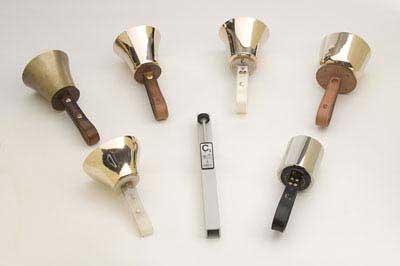
The Raleigh Ringers use the most extensive collection of handbells and bell-like instruments owned by a performing group in the world. The current grand total is 35 octaves composed of 377 individual pieces of equipment.
Malmark Handbells
The majority of The Raleigh Ringers’ music is performed on 7½ octaves of Malmark handbells, the group’s primary instrument. Spanning from G1, 2½ octaves below Middle C, to C9, five octaves above Middle C, this 90-bell set was manufactured by Malmark, Inc., of Plumsteadville, Pennsylvania. 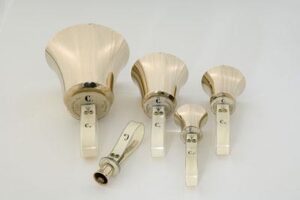
Most of the handbells in this set are cast in bronze, an alloy made of approximately 80 percent copper and 20 percent tin, with individual weights ranging from several ounces to more than 15 pounds. Polished inside and out, these bells have adjustable clappers, black and white polymer handles that match the color of modern piano keys, and polymer spring dampers. The smallest bells have metal clappers, the mid-range bells use polymer and sometimes felt on their clappers, and the largest bronze bells feature clappers covered with a combination of felt and yarn.
Because they’re cast in aluminum, The Raleigh Ringers’ lowest bass bells (G1 through E2) are lighter, yet larger in diameter, than their bronze counterparts of the same pitch. Weighing in at about 10 pounds, the “aluminums” don’t require polishing thanks to a light lacquer coating (used to treat aircraft wings!) on the surface. Another advantage of the aluminum bells is that they have a stronger fundamental relative to their overtones than do comparably pitched bronze bells, allowing their sound to be perceived at greater distances.
Malmark Choirchimes
Malmark’s Choirchimes resemble aluminum tuning forks with exterior clappers, although the bottom seven chimes are so large that they have no clapper mechanism and must be played with a mallet.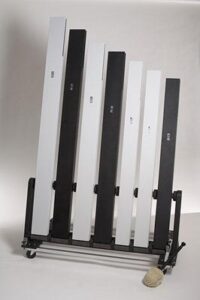
The chime’s prongs vibrate like those of a tuning fork, while the long tube serves as both a resonating chamber and a handle. They produce very quiet overtones relative to their fundamental pitches, which is why their sound approximates a mathematically perfect sine wave.
These extruded square aluminum tubes are extremely durable. The chimes’ clappers are stopped by rubber bumpers that contact the resonating chambers.

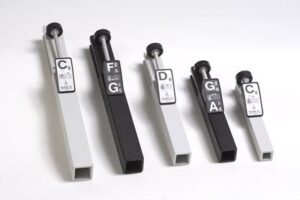
Whitechapel Handbells
Established in 1570, the Whitechapel Bell Foundry of London, England, is one of the oldest companies in the world still in continuous operation. Famous bells made by Whitechapel include Big Ben, the Liberty Bell, and the 10-bell peal at the National Cathedral in Washington, D.C. 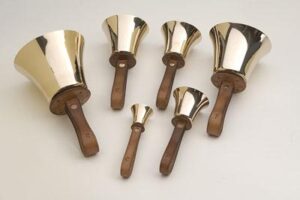
While Whitechapel handbells can be rung as a primary instrument, The Raleigh Ringers’ five octaves (61 bells, from C3 to C8) are most often used to add a rich, yet subtle interest to flowing melodic lines. The profile (shape) and bronze alloy from which Whitechapel handbells are cast result in a different appearance and sound from that of the Malmark handbells.
Leather clappers strike the castings with leather over most of the range; a polymer peg is used for the highest pitched bells and felt-covered leather clappers are employed in the lower bass bells. Whitechapel handbells have hand-tooled English leather handles, as well as a clapper-damping mechanism made of felt and metal.
Whitechapel Cup Bells
Whitechapel’s tuned musical Cup Bells have no clappers and are a bit clearer sounding than the original White Chapel handbells though they are made of the same bronze alloy. Our set was the first 4-octave set (49 bells, from C4 to C8) to be manufactured, and was one of the first sets to feature leather handles. 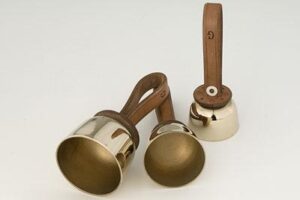
Cup bells are typically suspended from a rack, always played with mallets, and are very effective when used to introduce or close musical compositions. Cup bells are made of the same bronze alloy as Whitechapel handbells and are now available either with or without leather handles. On the inside, they maintain the rough texture formed during the casting process. They’re cut and polished on the outside to finish the cup-shape that gives them their name.
Petit & Fritsen Handbells
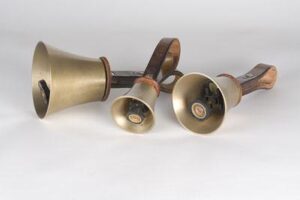 The sound of Petit & Fritsen handbells is very complex, but not quite as bright as that of the Schulmerich Silver Melody Bells. Upon first hearing these Dutch bells, people are often reminded of tower bells. The unique sound of the Petit & Fritsens comes from their differences in both the bronze alloy and the casting profile, resulting in yet another combination of fundamentals and overtones. The Raleigh Ringers’ three-octave, 37-bell set is occasionally used to simulate the sound of tower bells in change-ringing patterns, or to accent melodic lines.
The sound of Petit & Fritsen handbells is very complex, but not quite as bright as that of the Schulmerich Silver Melody Bells. Upon first hearing these Dutch bells, people are often reminded of tower bells. The unique sound of the Petit & Fritsens comes from their differences in both the bronze alloy and the casting profile, resulting in yet another combination of fundamentals and overtones. The Raleigh Ringers’ three-octave, 37-bell set is occasionally used to simulate the sound of tower bells in change-ringing patterns, or to accent melodic lines.
Petit & Fritsen handbells have leather handles, and their castings aren’t polished. Our set was retrofitted with Malmark clappers across the entire range (C4 to C7). Although Petit & Fritsen still manufactures carillons and peal bells, their handbells are no longer in production and are available as used sets only.
Schulmerich Silver Melody Bells
The Raleigh Ringers’ most fortunate find has been its set of Silver Melody Bells. An experimental product manufactured by Schulmerich Carillons, Inc., in the 1970s, these bells with cylindrically-shaped castings were never mass produced.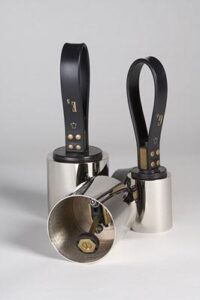
As a result, only a handful of the original two-octave, 25-bell (C5 to C7) sets existed - up until recently. Demand was so high that Schulmerich decided to manufacture these bells again. Their complex overtone structure makes them unsuitable for most chordal music; however, The Raleigh Ringers makes powerful use of them to accent musical lines.
All of the Silver Melody Bells have black polymer handles, adjustable clappers, and the rubber washer clapper-restraining system found in Schulmerich handbells. Founded in 1935, Schulmerich Carillons, Inc., began making the first English handbells designed and manufactured in North America in 1962.
J. C. Deagan Handbells
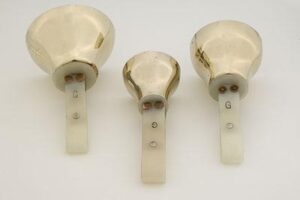 The Raleigh Ringers also own a two-octave set of J. C. Deagan handbells, named after the founder of the company that produced them. These rare bells are pear-shaped, and are comprised mainly of brass, instead of the customary bronze found in American-made handbells.
The Raleigh Ringers also own a two-octave set of J. C. Deagan handbells, named after the founder of the company that produced them. These rare bells are pear-shaped, and are comprised mainly of brass, instead of the customary bronze found in American-made handbells.
Because of their unusual shape and composition, these bells have a different overtone structure that is similar to our English-made Whitechapel bells. Fortunately, the overtone is not so different as to make them incompatible with our main set of Malmark handbells. When ringing identical bells from the Deagan and Malmark sets, some ringers believe they can hear a major chord from the mix of fundamentals and overtones. 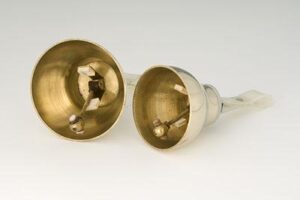
Deagan handbells were first manufactured at the turn of the 20th century, but due to brass being needed for shell casings and munitions for World War I, the company ceased production in 1917 and never restarted. The designs for the bells were eventually purchased by Jenco, Inc., a percussion instrument company; we believe our set to have been manufactured by Jenco in the early 1950's using the original Deagan designs.
Deagan Organ Chimes (Shaker Chimes)
One of the more recent acquisitions is an antique set of Deagan Organ Chimes, or Shaker Chimes as they are more commonly known. Shaker chimes are a rare instrument originally manufactured by the Deagan Company in the early 1900s.
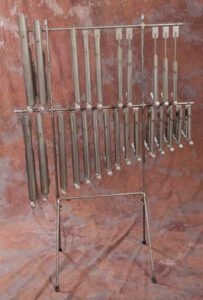
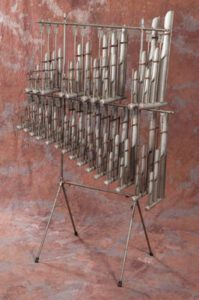 Shaped after the bamboo angklung from Indonesia, the instrument consists of a stand and 25 pendulums. Each pendulum contains three individual tube chimes tuned in octaves of the same note (low, mid, and high). When struck, pulled, or shaken, all three chimes on the pendulum strike the wooden base and resonate, creating a nice, full tone.
Shaped after the bamboo angklung from Indonesia, the instrument consists of a stand and 25 pendulums. Each pendulum contains three individual tube chimes tuned in octaves of the same note (low, mid, and high). When struck, pulled, or shaken, all three chimes on the pendulum strike the wooden base and resonate, creating a nice, full tone.
Each tube chime is air-resonance tuned. The resonant frequency of the air enclosed within the hollow tube matches the fundamental pitch of the ringing metal itself. The two reinforce one another. The air resonance frequency coincides with the fundamental in the metal tone, it does not match the metal's inharmonic partials, an effect that contributes to the clarity of pitch.
Cymbells®
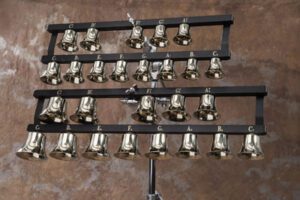 Cymbells, the last official invention of the late Jake Malta, are Malmark handbell castings mounted to a rack. The Raleigh Ringers owns four octaves of Cymbells, using them to add a descant or ostinato, reinforce a melody, bring out a counter melody, or used in place of a glockenspiel.
Cymbells, the last official invention of the late Jake Malta, are Malmark handbell castings mounted to a rack. The Raleigh Ringers owns four octaves of Cymbells, using them to add a descant or ostinato, reinforce a melody, bring out a counter melody, or used in place of a glockenspiel.
Additional Equipment
About Us
Upcoming concerts
Audience Comments
"The music was beautiful, the entertainment hilarious, and the whole experience was wonderfully worthwhile. We loved it so much we tried to get a flight changed to come hear your concert again!"
- Anonymous Fan
“What skill and diversity of music! I could have listened another three hours! Thank you for the inspiration and entertainment!”
- Anonymous Fan
“I never would have thought I'd want to go to a handbell concert, but when I heard handbell rock ’n’ roll on the radio, I told my friends, ‘We're going!’ And it was just great.”
- Anonymous Fan
"The Raleigh Ringers are the best handbell ensemble on the globe!!!!”
Greg Pysh
Minister of Music and Composer
Midland, Texas
“Wow!!!!!!!!!!!!! They never cease to amaze me. Their playing is so musical, their technique impeccable.”
Cordetta Valthauser
Handbell Soloist
Cleveland Area, Ohio
"Thank you all for being ambassadors of superb musicianship, amazing technique, and sharing the joy of doing something you love, which is contagious.”
Carolann Haley
Assistant to Director of Music Ministries
National Presbyterian Church, Washington, D.C.
“The Raleigh Ringers are truly a wonderful instrument. It is a joy to watch how precisely they respond to director David Harris' musical goals, and how audiences respond as well. This group has definitely attained 'handbell superstar' status.”
Jason Tiller
Sonos Handbell Ensemble
San Francisco, CA
“The best part was, in spite of all the amazing things that they can do with bells – the bass ringer assignments, flawless technique, and all of those kind of things – the best part was that it was musical. I simply enjoyed the music.”
Dean Wagner
Associate Director of Music and Organist
First United Methodist Church of Cuyahoga Falls, Ohio
“...I did not know how good 'good' is in bell ringing until I heard you. It was simply superb, and you must have known that from the unusually enthusiastic response from the audience.”
Ross MacKenzie
Chautauqua Institution
Chautauqua, New York
